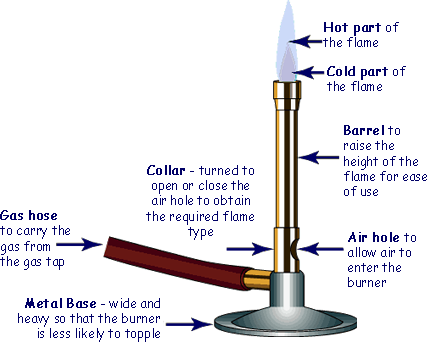What Is the Roaring Blue Flame Used for
The flame is used to heat metal or thermoplastics fusing them as they cool. That contained hydrogen and carbon monoxide - a poisonous explosive mix.

The Bunsen Burner Invented By Robert Wilhelm Bunsen Circa Ppt Download
The blue flame is generally used for expirements and is slightlyweaker than the roaring flame.

. The outside cone is the flame and it is blue the inside cone is unburned gas that is purple. It is approximately 500C. Roaring Blue Flame - The hottest flame characterized by a light blue triangle in the middle and it is the only flame of the 3 which makes a noise.
LPG propane and natural gas methane flame colour are both blue. Not yet appreciating the nature of burning he was not aware that the soot obtained when interrupting. The burner flames from your natural gas furnace should look blue or almost completely blue.
Most gas welding processes use oxyfuel welding. Increasing the amount of fuel gas flow through the tube by opening the needle valve will increase the size of the flame. There may be a tiny tip of yellow.
It is characterized by a light blue triangle in the middle and it is the only flame of the 3 which makes a noise. 9 Adjust the needle valve to adjust the height of the flame as needed 10 Keep opening the air ports to get to the next two types of flames but do not allow the flame to become a loud roaring blue flame. Blue Flame a.
To carry out a flame test a wire made from platinum or nichrome is dipped in acid then into the sample. Jim a Y7 student had been studying burning in science. Turn off the air vents if this does occur.
Blue flame vs yellow flame color is a question of complete combustion vs incomplete combustion. Its one of the oldest welding processes first developed in 1903. He had been using Bunsen burners and had been taught about the different flames ie.
The safety flame and the roaring blue flame used for heating and the use of the valve at the base of the burner to select the frame. It is the most commonly used flame. Medium Blue Flame - This flame is blue and useful for most laboratory applications.
It is approximately 500C. A blue flame color and temperature means complete combustion. Roaring blue flame - Strongest heating setting and is made of two cones.
It is called the safety flame. It is difficult to see in a well-lit room and is the most commonly used flame. The roaring flame is only used in expirements when.
A healthy natural gas furnace flame is characterized by a roaring blue flame with a light blue triangle in its center. It can be difficult to see in a bright room and is created when the air hole is partially open. It is not used for heating materials for an experiment.
Typically if youre looking at a typical lab setup a blue flame will be extremely hot excellent for sterilizing something and will have excellent combustion low soot content where soot gets in the way of making sure the surface is in fact sterile. Red flames or yellow gas flame color may be a sign of incomplete combustion wasted gas and a serious safety hazard. The medium flame also called the blue flame or the invisible flame is difficult to see in a well-lit room.
It is approximately 700C. Natural gas which is almost pure methane CH 4 is the fuel that you now get from the gas tap in the USA and the UK. This particular flame on a burner can get as hot as 500 degrees.
The hottest setting for Bunsen burner flames is the roaring blue flame. The sample on the wire is then held in a roaring blue Bunsen flame and. The hottest part of the flame is the tip of the inner flame while the coolest is the whole inner flame.
The hottest flame is called the roaring blue flame. Invisible flame or medium flame. However unless the airflow is adjusted as well the.
Before we converted to natural gas 1970s coal gas was supplied to the gas taps. Silent blue flame - Used to for gental heating and is silent and not very visible. Roaring Blue Flame - This is the only flame that makes noise It is the hottest flame with the hottest part of the flame being just at the tip of the white cone in the middle of the blue flame.
The Bunsen Burner is the most commonly used source of heat in school laboratories. Why is blue flame used for heating in the laboratory. Blue flames are hotter and indicate more complete combustion.
It can be gotten through opening thenole half-way. When the burner is regulated to produce a hot blue flame it can be nearly invisible against some backgrounds. Something absorbing energy and then emitting at that frequency.

Physics Revision Gcse And A Level Physics Revision Cyberphysics The Revision Website

Bunsen Burner With A Roaring Blue Flame When The Air Hole Is Open Stock Photo Alamy

Comments
Post a Comment